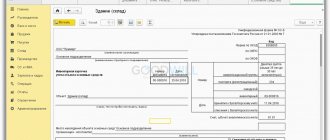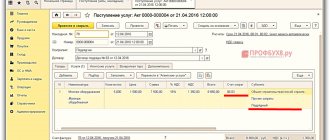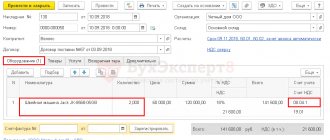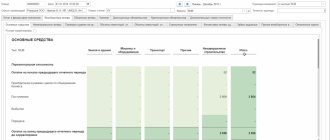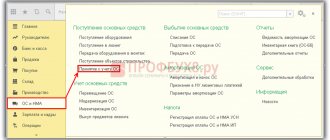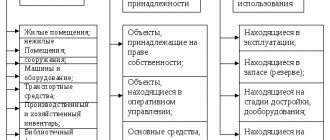Topic 2. Economic resources of the enterprise
Topic questions:
1. Formation and composition of the enterprise’s property.
2. Fixed assets: concept, material and cost form. Classification of fixed assets.
3. Working capital: concept, material and cost form. Classification of working capital.
The purpose and objectives of studying the topic:
consideration of the role and essence of the economic resources of the enterprise; classification of fixed and working capital.
After studying the topic, the following knowledge should be acquired:
formation and composition of the enterprise's property, the system of enterprise funds.
When studying the topic, it is necessary to focus on the following concepts: property, fixed assets, working capital, material and cost form of the enterprise's assets, production capacity.
Theoretical material of topic 2
GLAVBUKH-INFO
Fixed assets are used in the work of almost all organizations and represent part of the organization’s property, usually used as means of labor in the production of products (works, services) or for the management needs of the organization for a long time.Organizations may also acquire fixed assets for the purpose of their subsequent provision for a fee for temporary use (temporary possession and use) to other organizations and/or individuals.
For accounting purposes, the concept of “fixed assets” is disclosed through a candy list of one-time conditions established by the Accounting Regulations “Accounting for Fixed Assets” PBU 6/01 (hereinafter referred to as PBU 6/01).
In accordance with the amendments made to PBU 6/01, from January 1, 2006, property (asset) that simultaneously meets the following conditions can be accepted as an object of fixed assets for accounting:
- the object is intended for use in the production of products, when performing work or providing services, for the management needs of the organization, or for provision by the organization for a fee for temporary possession and use or for temporary use;
- the object is intended for use for a long time, i.e. a period lasting more than 12 months or the normal operating cycle if it exceeds 12 months;
— the organization does not intend the subsequent resale of this object;
- the object is capable of bringing economic benefits (income) to the organization in the future.
Taking into account the changes made, from January 1, 2006, profitable investments in material assets are also recognized as fixed assets.
The useful life is the period during which the use of an item of fixed assets brings economic benefits (income) to the organization.
Thus, the norms of PBU 6/01 establish that:
- assets with a useful life exceeding 12 months or a normal operating cycle, if it exceeds 12 months, regardless of their cost, must be classified as fixed assets;
— assets with a useful life of less than 12 months must be accounted for in relation to the procedure established for accounting for materials.
The usual operating cycle is a characteristic of the production process as the average duration of production of a product (work, service) from start to finish in a specific organization. If the normal operating cycle of an organization is 15 months, then assets with a useful life of up to 15 months can be accounted for as materials, and those with a useful life of over 15 months should be accounted for as fixed assets.
Despite the changes made, the procedure for recording assets classified as fixed assets in the accounting accounts remained the same as before January 1, 2006>
— assets intended for use in the production of products, when performing work or providing services, or for the management needs of the organization, are taken into account in account 01 “Fixed Assets”;
- assets intended to be provided for a fee for temporary possession and use or for temporary use are accepted for accounting in account 03 “Income-generating investments in material assets”,
In accordance with the changes made to PBU 6/01, from January 1, 2006, assets in respect of which the above conditions are met, and with a value within the limit established in the accounting policies of the organization, but not more than 20,000 rubles per unit, can reflected in accounting and financial statements as part of inventories, i.e. they can be reflected in account 10 “Materials” and not in account 01 “Fixed Assets”.
In order to ensure the safety of such objects in production or during operation, the organization must organize proper control over their movement.
For accounting purposes, fixed assets are classified according to various criteria. Classification of fixed assets according to various criteria plays an important role in obtaining reliable information about fixed assets and their correct accounting. The composition and grouping of fixed assets are regulated by the All-Russian Classifier of Fixed Assets (OKOF).
According to OKOF and P6U 6/01, fixed assets, according to their composition and purpose, are divided into the following groups:
— “Buildings (except residential)” (code 11 0000000) are architectural and construction facilities (production buildings, workshops, warehouses, etc.), the purpose of which is to create conditions (protection from atmospheric influences, etc.) for labor, socio-cultural services to the population and storage of material assets;
— “Structures” (code 12 0000000) are engineering construction objects (bridges, roads, dams, etc.), the purpose of which is to create the conditions necessary for the implementation of the production process by performing certain technical functions not related to changing the subject of labor, or for the implementation of various non-productive functions;
— “Machinery and equipment” (code 14 0000000) are devices that convert energy, materials and information.
Depending on the main purpose, machines and equipment are divided into energy (power), work and information.
Energy power equipment includes: generator machines that produce thermal and electrical energy, and engine machines that convert any type of energy into mechanical energy.
Working machines and equipment include machines, tools, apparatus and other types of equipment intended for mechanical, thermal and chemical effects on the object of labor (the object being processed).
Information equipment is equipment designed to convert and store information. Information equipment includes equipment for communication systems, measurement and control equipment, computer equipment and office equipment (computers, printers, copying machines, typewriters, calculators, etc.), means of visual and acoustic display of information, information storage equipment, etc. ;
- “Vehicles of transport” (code 15 0000000) are vehicles designed to move people and goods. These include locomotives, wagons, transport ships, rescue ships, icebreakers, trucks and cars, buses, trolleybuses, trams, subway cars, airplanes , helicopters, etc.;
- “Industrial and household inventory” (code 16 0000000) includes:
- Production equipment is technical items that are involved in the production process, but cannot be classified as equipment or structures.
It includes containers for storing liquids (vats, barrels, tanks, etc.), devices and furniture that serve to facilitate production operations (work tables, counters, trade cabinets, shelving, etc.);
- household equipment ~ these are office and household items not directly used in the production process (watches, fire-fighting items, sports equipment, etc.);
“Working, productive and breeding livestock (except for young animals and livestock for slaughter)” (code 17 0000000) - these are horses, oxen and other working animals; cows, sheep, and other animals that are repeatedly or constantly used to produce products (milk, wool, etc.); stud stallions and broodmares, stud bulls, cows, stud boars and other breeding stock;
- “perennial plantings” (code 18 0000000) are all types of artificial perennial plantings, regardless of their age. These include:
- fruit and berry plantings of all types (trees and shrubs);
- landscaping and decorative plantings (on streets, squares, parks, gardens, squares, on the territory of enterprises);
- hedges, shelterbelts, plantings to strengthen sand and river banks. The belonging of fixed assets to an accounting group is determined on the basis of passports, operating instructions, descriptions and other technical documentation.
The following are also taken into account as part of fixed assets: capital investments for radical improvement of land (drainage, irrigation and other reclamation works); capital investments in leased fixed assets; land plots and environmental management facilities (water, subsoil and other natural resources).
From January 1, 2001, according to PBU 6/01, apartments that were previously included in intangible assets were also classified as fixed assets.
Fixed assets, according to the degree of their use, are divided into objects located:
- in operation;
- in stock (reserve);
- under repair;
- at the stage of completion, additional equipment, reconstruction, modernization and partial liquidation;
- on conservation.
Fixed assets in operation include all operating fixed assets listed on the organization's balance sheet, including those temporarily unused or leased.
Fixed assets in stock (reserve) include equipment and vehicles purchased to create a reserve, as well as used fixed assets that are temporarily taken out of service.
Fixed assets under conservation include fixed assets placed on conservation for a period of more than three months. The transfer of fixed assets for conservation is carried out by decision of the head of the organization and is documented in documents indicating the composition of fixed assets transferred for conservation and the period for which they are transferred for conservation.
Fixed assets, depending on the rights the organization has, non-fixed assets are divided into:
- fixed assets owned by an organization (including those leased, transferred for free use, transferred to trust management);
- fixed assets that are under the operational management or economic control of the organization (including those leased, transferred for free use, transferred to trust management);
- fixed assets objects received by the organization for rent;
- fixed assets received by the organization for free use;
- objects of fixed assets received by an organization for trust management. Fixed assets, depending on their intended use, are divided into fixed assets for production and non-production purposes.
Production fixed assets include objects whose use is aimed at systematically generating profit as the main goal of activity, i.e. use in the production of industrial products, in construction, agriculture, trade and public catering, procurement of agricultural products and similar activities.
Non-productive fixed assets include objects that are listed on the organization’s balance sheet and do not fall under the above definition, i.e., are not related to the implementation of its statutory activities and operate in the non-productive (social, etc.) sphere.
The main non-production facilities include facilities for the operation of residential buildings, as well as residential buildings, dormitories, bathhouses, laundries, canteens and buffets, preschool institutions (kindergartens, nurseries), rest homes, sanatoriums and other cultural institutions .
Tax aspects. For tax accounting purposes, fixed assets are divided into depreciable and non-depreciable fixed assets.
Depreciable fixed assets are property with a useful life of more than 12 months and an initial cost of more than 40,000 rubles, which is owned by an organization, used by the organization to generate income, and the cost of which is repaid by calculating depreciation.
For the purposes of tax accounting of fixed assets, a special Classification of fixed assets included in depreciation groups, approved by Decree of the Government of the Russian Federation dated January 1, 2002 No. 1, must be applied.
This Classification was developed on the basis of OKOF and can also be used for accounting purposes, in particular to determine the useful life of fixed assets received by the organization.
For accounting purposes, this Classification can only be applied to those fixed assets that were acquired and accepted for accounting after January 1, 2002.
What is the cost of fixed assets
Next, we will consider what the cost of fixed assets is and what types it is divided into. It is necessary to determine the real value of fixed assets in various commercial situations. Firstly, it is worth talking about what the book value of fixed assets is and what its essence is.
With its help, records are kept of the availability and movement of the value of the above funds on the organization’s balance sheet. As with margins, there are differences in the cost of fixed assets at different production stages.
There is also the concept of wear and tear, that is, the loss of part of the value of fixed assets. It occurs as a result of long-term use of such means and can be caused by various reasons, both material and intangible.
The main types of wear and tear: physical (occurs both during operation and from inactivity), social (purchase of new equipment with increased comfort, safety, etc.), environmental (tightening standards in the environmental field), complete (depreciation).
Types of funds
Conventionally, all funds in an enterprise can be divided into several types:
Production; Non-productive.
At the same time, production assets are divided into:
- Industrial;
- Manufacturing in other industries.
Production and industrial funds are divided into:
- Active part;
- Groups that perform their assigned functions.
Such a detailed separation is necessary in order to be able to discover resource efficiency improvements based on structure optimization.
Depreciation of fixed assets: what is it?
Let's understand what depreciation of fixed assets of an enterprise is. This is the transfer of part of the value of fixed assets to a newly created product for the subsequent reproduction of fixed assets by the time they are completely worn out. Depreciation in cash expresses the depreciation of fixed assets, which is the reason for the increase in inflation based on depreciation rates.
The depreciation method is chosen by the enterprise independently, along with the intended method of obtaining economic benefits from its use. At the same time, different depreciation methods are used for different objects.
Today we looked at such an integral part of the production process as fixed assets. And creating a business card website is an important part of the promotion process.
Formation and composition of the enterprise’s property
An enterprise carries out its activities using economic resources or factors of production. Among them, capital and production resources occupy the most important place.
Property (economic funds, assets) is formed from financial resources, which in turn are divided into own and borrowed. To start its activities, an enterprise must have its own capital, in which a special role belongs to the authorized capital.
Authorized capital
represents the amount of cash and other assets contributed by the founders when creating the enterprise. The authorized capital is the economic foundation of the enterprise.
Property
is a set of tangible, intangible and financial elements (assets) owned by an enterprise and used to carry out its activities.
Tangible assets are buildings, equipment, raw materials, finished products.
Intangible assets include: patents, trademarks and brands, business reputation, copyrights and other types of intellectual property.
Financial assets include: cash on hand and in the current account, securities, contributions to the authorized capital of other enterprises.
The relationship between capital and property can be viewed through the structure of the balance sheet. The capital or sources of funds of an enterprise are presented in the liabilities side of the balance sheet. They are divided according to ownership into own and borrowed. Borrowed loans are also divided according to their terms into long-term and short-term.
The property of the enterprise is reflected in the balance sheet asset; it is divided into non-current and current assets. Assets are formed impersonally from sources of funds and are the property of the enterprise.
The company is liable for its debts with all its property, which once again confirms the inseparability of capital and property.
What is an object of fixed assets
Now let's talk about what a fixed asset is and what it includes. The object of cheap SEO promotion is a website, and the objects of the above-mentioned means are: buildings, structures, on-farm roads, machinery and equipment, vehicles, tools, etc.
All fixed assets are classified into production (participating in the production of goods and services, or in creating conditions for work) and non-production, having social significance without participation in production activities). There is also a division into active and passive fixed assets.
